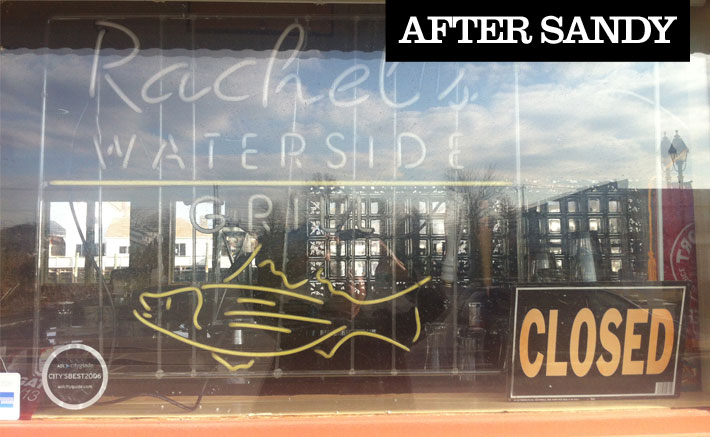
Keep It Like A Secret
Mangano’s response at Cedar Creek has been swift, decisive and ongoing in the wake of its exposure.

To The Rescue: Nassau's response to Bay Park Sewage Treatment Plant's devastation include Fred Maroni (in hat) and Michael Fasano, standing alongside a newly repaired final tank recently put back in service by county workers.
Among other improvements, the inoperative methane gas valves tested by the Press, which internal records revealed had been non-functioning since at least 2005, have all been replaced.
Purchasing has been fast-tracked, meaning critical parts that had gone requested, though unfulfilled for years, have been ordered, are making their way into the plant and are being installed. There are weekly staff meetings where occurring problems are addressed. Overtime has been freed up, with crews of county employees now finally able to do the jobs they knew needed to be done but were prevented from doing. Training and education programs are being implemented whereby employees can obtain much-needed operator licenses.
Cedar Creek’s beleaguered bar screens—critical to collecting large debris and other contaminants as they enter the plant so they don’t damage or destroy machines in subsequent stages of the treatment process (none were working at one point)—have all been repaired. One of the Creek’s three inoperable grit tanks—gigantic, canyon-esque chambers crucial to removing solids—is fully operating and a second should be up shortly.
Four maintenance mechanics have been hired, two in the power plant section, and there’s a request for 20 operator trainees, to be split between both plants; still short of adequate staffing, but important steps, say plant workers. Personnel from Woodbury-based Cameron Engineering, a firm with expertise in wastewater engineering, have also been brought in: John Pascucci, Tom Burke and Mark Wagner.
Even Terence Hopper, head of plant maintenance at Cedar Creek, frustrated for years at the mismanagement of the plant—who risked his job to speak out about the plant’s myriad hazards and received death threats, suspected from someone at Bay Park, for that whistleblowing—is excited.
“For the first time, we’re moving forward,” he tells the Press. “For the first time, it’s, all the politics is pushed aside, it’s getting down to the nitty-gritty.”
“In a few short months, the Cedar Creek Water Pollution Control Plant has been brought back to a condition of the highest safety standards with respect to Methane production and distribution throughout the plant,” adds a satisfied Phil Franco, co-chair with Mark Salerno, of the watchdog Cedar Creek Health Risk Assessment Committee.

In The Hot Seat: Nassau's embattled Superintendent of Sewage Plants Richard Cotugno
Perhaps one of the most important changes made in lieu of Press stories, workers and watchdogs add, has been the removal of Cotugno from day-to-day operations of both plants—announced by Nassau’s Chief Deputy County Executive Rob Walker at an impromptu meeting at Cedar Creek in August. Instead, he’s been relegated to desk duty at Nassau Department of Public Works headquarters in Westbury, dealing with demands and orders from the DEC regarding Bay Park’s recent violations, county officials say. [Though he’s still collecting his $132,000-a-year-plus salary, compliments of Nassau taxpayers—and it’s taxpayers who will have to pay any resulting fines and penalties.]
Yet many, many unanswered questions remain about his tenure [and few records or maintenance logs exist]. Taxpayers’ and legislators’ demand to know what happened to the millions upon millions of dollars paid throughout the years for the upkeep of the plants to why he shut down and dismantled a state-of-the-art onsite laboratory capable of conducting time-sensitive tests of samples to guarantee brown plumes never get released into receiving waters, to inquiries about stifled promotions.
And one thing is, unfortunately, now crystal clear.
Long suspected to be in as bad a condition, or worse, than Cedar Creek—which previous Press stories revealed was brought to the brink of catastrophe due to years of nearly zero preventive maintenance (the equivalent of changing the oil of a vehicle to prevent engine failure) of its taxpayer-financed multi-million dollar equipment and machinery, the lack of adequate personnel and gross mismanagement, among many, many other ailments—Bay Park has suffered years of similar abuses.
Cotugno’s favorite son since it’s where he rose through the ranks, say Cedar Creek and Bay Park workers, he pitted employees of the two facilities against each other, constantly taunting them that Bay Park’s condition was far superior to the Creek’s. Now, crews at both plants are working together with each other. In reality, the silent sister by the bay is arguably far, far worse.
Describing its many challenges and outlining their plan of attack during the recent meeting and tour of the facility was: Nassau’s Department of Public Works Commissioner Shila Shah-Gavnoudias, Assistant to the Commissioner Kenneth Arnold, DPW Deputy Commissioner Richard Millet and Community Service Representative Michael Fasano [a team Hopper praises], Superintendent of Buildings Fred Maroni (who’s now in charge of maintenance), Operations Assistant Philip Saglimbene of Dvirka and Bartilucci Consulting Engineers, and Press Secretary Michael M. Martino, Jr.
Fasano, Maroni and Saglimbene guided the tour, though the Press requested additional stops.
Critical (again, taxpayer-financed) machines and equipment sit in various states of disrepair, some in need of complete replacement, many requiring immediate attention at the least, all suffering from a lack of preventive maintenance or proper repair work. The majority are outdated. Pumps are worn out. Valves are inoperative, useless. Mechanisms are mismatched and near or far past their respective breaking points. Some, such as one of the main roots of the illegal discharge problem—the grimy, stinky situation taking place in the Sludge Thickening Building—appear simply abandoned, just too far gone.

Gross Neglect: Nassau's Bay Park Sewage Treatment Plant's Sludge Thickening Building is loaded with caked sludge that has been unable to be properly treated due to a chronic lack of preventive maintenance and manpower throughout the facility. (Christopher Twarowski / Long Island Press)
“This is the problem!” shouts Saglimbene over the roar of machinery within.
Inside are vats of thick, vile absolutely putrid, solid waste resembling a molten lava flow caked in excrement in varying states of suspended liquids, spanning the equivalent of half an enclosed football field, barely moving, oozing and solidified like the alien terrain of some Godforsaken outer-ringed moon of hell.
At the heart of Bay Park’s illegal discharges is that not enough solids are being removed from the treatment process. That’s due to myriad reasons, one of them being chronic process and equipment failures throughout the plant, not the least the inability to treat, press and remove all its sludge.
“You’re talking about years of neglect to infrastructure,” Deputy DPW Commissioner Millet explained. “This is a multitude of sins compounded on top of each other.”
To help resolve this, the county brought in Maroni and Saglimbene, who are on their third week, to function as maintenance and operations supervisors, in essence, to get things done. They’ve replaced Bay Park’s management team (Hopper’s equal is now checking sticks of oil in Eisenhower Park), authorized emergency contracts, and have been replacing and upgrading critical equipment throughout.
Utilizing county workers, they’ve brought eight final tanks—one of the last stages in the treatment process before effluent flows into Reynolds Channel—back from the dead. All 10 are now online. Six of eight primary tanks are operational; only one worked when they arrived. One grit tank is now running, with another under repair. Excess sludge was trucked to Cedar Creek for processing.
“They knew these problems, these guys, and then, for whatever reason, they were handcuffed,” explains Fasano. “But I assure you, the handcuffs are off now. And they’ve been producing.”
Both plants are working as a team now, instead of as enemies.
Maroni explains a recent, vitally important trade he struck up with Hopper. Cedar Creek had valves that Bay Park needed. So Hopper gave them to Maroni and now Maroni will order more for when Wantagh’s plant needs them. The interaction saved time and money, he says:
“These valves I’m talking about are a 16-week lead time, that’s once we get through the county approval. So that’s six months to get valves that I got in six hours.”

Diversion Tactics: New pipework has been laid at Nassau's Bay Park Sewage Treatment Plant to help process sludge and get its vital mechanisms back up and running at ideal capacity to prevent illegal discharges.
Shah-Gavnoudias, who tells the Press the county only became aware of Bay Park’s horrors when it learned of the brown plumes in mid-October, said the solution to the illegal discharges is the installation of temporary equipment called Gravity Belt Thickeners, or GBTs. Bay Park needs two for now. Permanent GBTs will be installed by 2012, she said.
They’ll enable the quicksand-like vats in the Thickening Building to be circumvented and the rest of Bay Park’s jammed systems to catch up with itself. One unit—which looks sort of like a massive, robotic foosball table, complete with giant rows of mini paddles arranged across its top surface—has arrived; crews were actively working to get it online. Another will be running by mid-January.
Until then, the sludge in the channel will continue.
For some, that’s simply not acceptable. It never should have happened in the first place, they charge. Those responsible should be held accountable.
That’s exactly what longtime environmentalist Morris Kramer of Atlantic Beach, who’s dedicated the past 45 years of his life to protecting the ocean, the Western Bays and Long Island’s water supplies, wants.
“If they can make a criminal case against Cotugno—because these workers have been so inhumanely treated—they should squeeze him until you can squeeze where it goes, to the highest level possible, including the previous county executive.”






